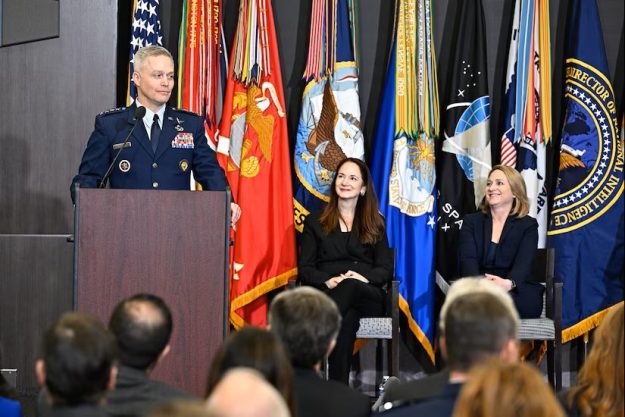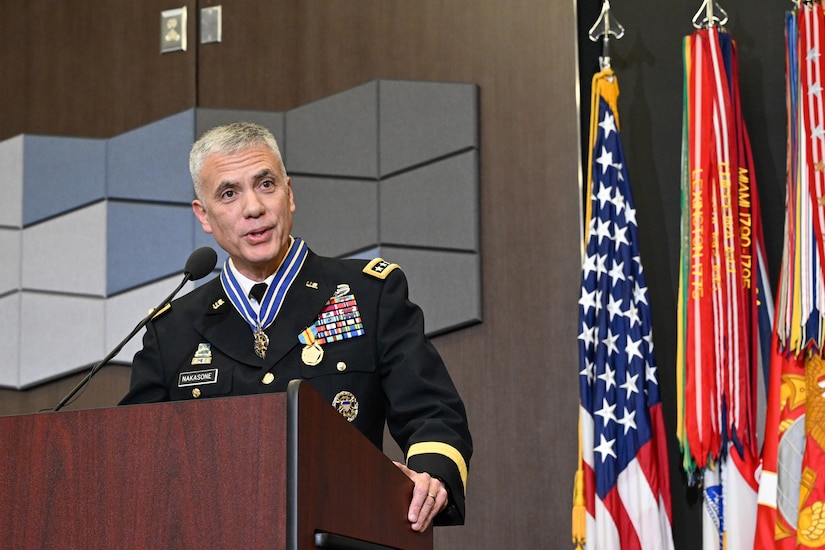Leaders from the Defense Department and intelligence community gathered at Fort Meade, MD, last week for the change of command ceremony of U.S. Cyber Command, as Army Gen. Paul M. Nakasone passed the flag to Air Force Gen. Timothy D. Haugh.
Haugh also became the director of the National Security Agency and the chief of the Central Security Service. The change of command took place in the Shannon Kent Conference Center at the command’s new headquarters. Kent was a Navy senior chief cryptanalyst killed in Syria in 2019.
Deputy Secretary of Defense Kathleen Hicks presided at the change of command, and the Director of National Intelligence Avril D. Haines presided as Haugh assumed the NSA/CSS directorship. Navy Adm. Christopher Grady, vice chairman of the Joint Chiefs of Staff, represented the Joint Staff at the event.
Cyber Command is a combatant command that is constantly at war, ensuring the U.S. military has secure communications. Enemies — from nation states to hackers — constantly attack the network as they seek to disrupt military operations worldwide. The command defends the network and nation through full-spectrum offensive and defensive operations. Cyber Command also works with other U.S. government agencies and with allies and partners worldwide.
The National Security Agency and Central Security Service lead the nation in cryptology and signals intelligence and also develops cybersecurity products and services.
The massive campus at Fort Meade is the headquarters for an organization that stretches across the globe and into space.
Nakasone took command in 2018 when Cyber Command was still new, having been established in 2010.
“People at Fort Meade are tackling some of the most important missions in the Department of Defense,” said Hicks in remarks at the ceremony. “Day and night, Cybercom keeps the watch in cyberspace.”
Every American benefits from the mission as the Internet is vital to U.S. democracy, America’s way of life, and the world’s economic well-being. “We rely on cyberspace to be free, open and secure; so every day, Cybercom works hard to ‘own the domain,'” she said.
The command evolves as the threats evolve, Hicks said, and the people of the command must adapt to outpace adversaries and ensure the safety and reliability of the digital world.
“In the 21st century security environment, you are the front lines,” Hicks said. “Our competitors are looking to degrade our military advantage — to threaten our infrastructure, our information systems, and our industrial base.”
China is the pacing challenge as the only strategic competitor with the will and, increasingly, the means to remake the international rules-based order that has prevented great power war since 1945. “[China] seeks to spread its brand of autocracy through digital means: like intrusive hardware and software, forcing tech to comply with political ideologies, stealing [intellectual property] and trying to dominate the telecom and cybersecurity industries,” Hicks said.
Russia is also an acute threat, the deputy secretary said. “They’ve launched troubling influence campaigns meant to interfere in our elections and undermine our democracy, while their cyber criminals have launched damaging ransomware attacks,” she said. “Russia’s cyberattacks have tried to weaken Ukraine’s military and damage civilian infrastructure there. And their global online-propaganda campaigns try to justify their unprovoked aggression.”
Nakasone worked across an array of threats, which ranged from cyber operations to combating Islamic State terrorists, to position Cyber Command and the NSA for strategic competition with China and Russia.
“His transformational leadership has strengthened our national security, bolstered our deterrence and defended our democracy — including protecting U.S. elections from foreign attacks,” Hicks said. “Above all, he understands that cybersecurity is a team sport. That’s why he has coordinated closely across the interagency: recognizing that our cyber capabilities must be used alongside other instruments of national power.”
In-coming commander Haugh is well-versed in the organizations after having served at Nakasone’s deputy. He has had a long history in intelligence and cyber fields since he commissioned into the Air Force in 1991. “Tim, this command, these agencies, and their people are fortunate to have you lead them into their next era,” Hicks said. “We look forward to everything you will do here to strengthen these institutions and their teams and to make America even more secure.”
Nakasone and Haugh stressed the importance of the people of the command and agencies. Nakasone said that while technology is important, it is the people who make the difference. They are the innovators, and they are the reason the American people respect the organizations, he said.
“Our talent is unmatched in the world,” Haugh said in his remarks. “The National Security Agency and Cyber Command create advantages for the nation.”
The organizations will continue to create and use new technologies because “that is part of our enduring advantage,” the Air Force general said. He said the watchwords of his term will be “people, innovation and partnerships.”
Haines said the intelligence community, writ large, is a team sport and that Cyber Command and NSA are essential players. She said Nakasone provided the highest levels of government with the intelligence needed to make informed decisions. Haines also presented Nakasone with the George Washington Spymaster Award, the highest award in the intelligence community.
Nakasone leaves after six years in the positions. Grady praised the Army general for his leadership through the pandemic, for growing cyber operations in all domains of warfare, for the increasing agility of the command and for his outreach efforts to allies, partners and, increasingly, to private entities.




